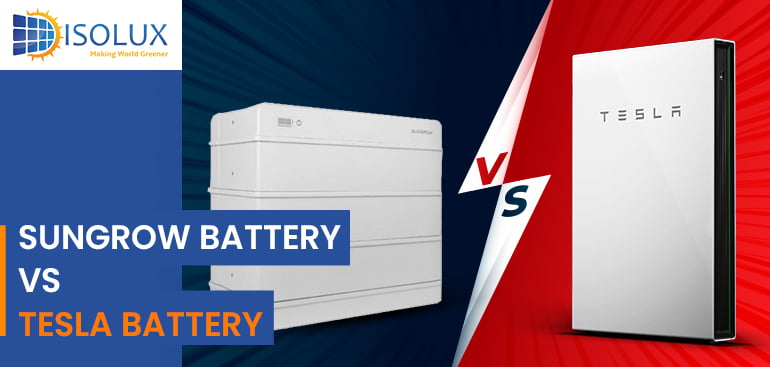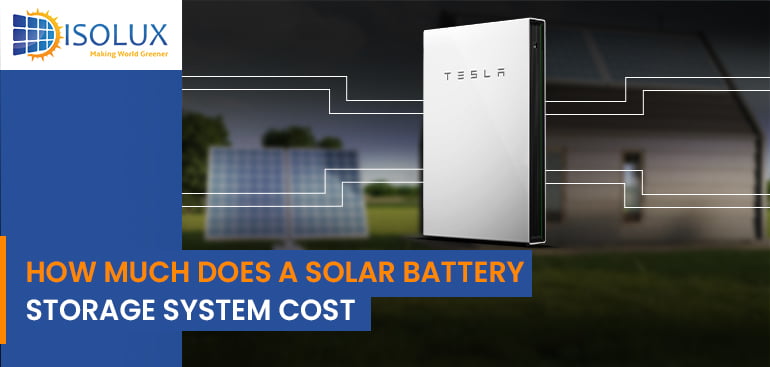When it comes to home energy storage solutions, two prominent names in the market are Sungrow and Tesla. As a top solar installer in Sydney, Isolux Solar understands the importance of choosing the right battery system to complement your solar installation. Let’s compare the advantages and disadvantages of Sungrow and Tesla batteries to help you make an informed decision.
Sungrow Batteries
Sungrow, a Chinese company founded in 1997, has gained a reputation for its cost-effective and safe battery solutions. Each Sungrow battery module has a capacity of 3.2 kWh, and you can stack up to eight modules for a total capacity of 25.6 kWh. This modularity means you can tailor the battery size to your specific energy needs, avoiding the unnecessary expense of oversizing. Their lithium iron phosphate (LFP) batteries, such as the SBR HV series, offer several advantages:
Cost-effectiveness: Sungrow batteries are generally more affordable than Tesla’s offerings, making them an attractive option for budget-conscious homeowners.
Safety and Stability: LFP batteries are known for their excellent safety and stability characteristics, with a lower risk of thermal runaway and fire hazards.
Three-Phase Support: Sungrow batteries support three-phase systems, allowing for faster charging of electric vehicles with a maximum capacity of 10 kW.
Flexible Capacity: Sungrow batteries are modular, allowing you to customize your energy storage system from 9.6 kWh to 25.6 kWh for a single string and up to 102.4 kWh by combining multiple strings.
However, Sungrow batteries also have some drawbacks:
Limited Brand Recognition: Compared to Tesla, Sungrow may have limited brand recognition in some regions, which could impact customer confidence.
Limited Distribution Network: Sungrow’s distribution network may not be as extensive as Tesla’s, potentially leading to challenges in availability and customer support.
Tesla Batteries
Tesla, a well-established brand in the electric vehicle and energy storage industry, offers the Powerwall battery system. Here are some key advantages of Tesla batteries:
Established Brand and Reputation: Tesla’s brand recognition and reputation instill confidence in customers regarding the reliability and performance of their products.
Advanced Battery Chemistry: The Powerwall utilizes nickel-cobalt-aluminum (NCA) battery chemistry, offering high energy density and compact form factor.
Grid Independence: The Powerwall is designed to operate independently from the grid, providing backup power during outages and ensuring uninterrupted power supply.
However, Tesla batteries also have some drawbacks:
Higher Cost: Tesla batteries, including the Powerwall, are generally more expensive compared to other battery options in the market.
Limited Three-Phase Support: Currently, the Powerwall does not support three-phase battery systems, which may be a limitation for some households.
Warranty and Support
Sungrow offers a 10-year warranty on its batteries, guaranteeing at least 60% of the original capacity during that period. Tesla, on the other hand, provides a 10-year warranty with a minimum of 70% capacity retention for the Powerwall.
In terms of support, Tesla has a strong presence in Sydney and Australia, with a dedicated service network. Sungrow, while a reputable brand, may have a more limited support network in certain areas.
Cost Comparison
When it comes to cost, the Sungrow battery typically has a lower upfront price compared to the Tesla Powerwall. For example, a 12.8 kWh Sungrow battery system can cost around $9,500 plus installation, while a Tesla Powerwall 2 (13.5 kWh) can cost around $14,000 plus installation in Sydney.
However, it’s important to note that the cost difference may be offset by the Powerwall’s advanced features, brand recognition, and potential resale value.
Conclusion
Both Sungrow and Tesla batteries offer unique advantages and disadvantages. Sungrow batteries provide cost-effectiveness, safety, three-phase support, and flexible capacity options, making them an attractive choice for homeowners in Sydney. On the other hand, Tesla batteries boast an established brand, advanced battery chemistry, and grid independence features, appealing to those who prioritize brand recognition and backup power capabilities.
When choosing between the two, it is essential to consider factors such as budget, specific requirements, and the availability of support in your area. As a top solar installer in Sydney, Isolux Solar can guide you through the selection process and ensure a seamless integration of your chosen battery system with your solar installation.
FAQs
Q: Which battery is more cost-effective?
A: Sungrow batteries are generally more affordable than Tesla Powerwall batteries, making them a cost-effective option for budget-conscious homeowners.
Q: Which battery offers more flexible capacity options?
A: Sungrow batteries are modular and can be customized from 9.6 kWh to 25.6 kWh for a single string and up to 102.4 kWh by combining multiple strings, providing more flexible capacity options compared to the Tesla Powerwall.
Q: Which battery offers better grid independence and backup power capabilities?
A: The Tesla Powerwall is designed to operate independently from the grid, providing backup power during outages and ensuring uninterrupted power supply, while Sungrow batteries may not offer the same level of grid independence.




